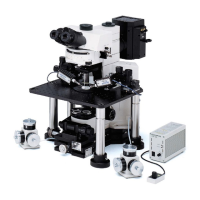32
3 DIC Observation Using IR
Since IR light is harmful to your eyes, use the monitor observation whenever possible even in adjustments.
1. First, perform adjustments for DIC observation without using IR.
}Do not mount the IR filter and see Section 5-1, “Differential Interference Contrast Observation” on page 24.
· Focus the field iris diaphragm image (page 21).
Be sure to perform this adjustment accurately because it determines the visual performance
using the IR light.
· With DIC observation using IR, do not stop down the aperture iris diaphragm lever 1 but
leave the diaphragm open. Since the contrast can be enhanced by the video enhancement
function of the CCD camera controller, the diaphragm should be left open here so that the
system can manifest full performance.
IMPORTANT
2. Then engage the IR filter (32BP775 or 32IR900) in the light path by pushing in the filter slider.
3. While observing the monitor, perform DIC observation using IR.
a) Turn the condenser turret (other than the WI-DICD) to select the DIC prism matching the objective to be used.
b) Engage the objective to be used in the light path.
# Penetration of air bubbles inside the front lens of objective will deteriorate the view. To prevent this by removing
the bubbles, turn the revolving nosepiece slightly to move the immersed objective to the left and right for a few
times.
c) Bring the specimen into focus by moving the objective up and down.
4. Turning the 32POIR polarizer varies the density of the background. Set the polarizer to obtain optimum contrast for the
specimen.
1

